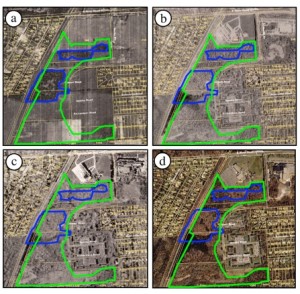
The University of Rochester’s South Campus notably consists of the Laboratory for Laser Energetics, Whipple Park, and the Alumni and Advancement Center. What is not quite as known to most is that South Campus is also home to an ecologically rich, biodiverse old-growth forest. An old-growth forest occurs when a forest has attained great age without significant disturbance and thus has unique ecological features.
As part of a larger analysis of old-growth forest land across Monroe County, Assistant Professor Justin Ramsey and Research Associate Tara Ramsey of the University of Rochester Biology Department have spent several years studying the South Campus area (or as they call it, the Whipple Woods). The Ramseys, joined by student field crews, have conducted extensive site surveys and data collection to research the distribution of plant life in the forest. According to Mr. Ramsey, Monroe County has a surprising amount of quality old-growth forest, which is very rare in our age of development and land clearing. Among the 24 old-growth properties that the Ramseys have studied in the area, Whipple Woods was found to be most noteworthy for its plant diversity with the highest species richness.
The Ramseys emphasize the value of the Whipple Woods for teaching efforts, field trips, and recreational activities. In 2010, the Ramseys received a National Science Foundation grant to fund their research. The grant supported their research, allowing them to focus on plants, education, and forests all around Rochester. As Justin Ramsey says, “[The Whipple Woods] is an amazing place ecologically and nobody knows that.”
Beyond the study of plant distribution and genetics, the Ramsey crew built trails, enacted controls on certain invasive plants, and served to manage the Whipple Woods. The trails benefit the area by keeping people off sensitive areas that would be damaged from being stepped on and disturbed. Through their studies, they discovered that there are many old growth spots and as Justin Ramsey said, “Monroe County is an ecological goldmine.” These sites contain diverse plant life and very large trees that in some cases starting growing 250-300 years ago, well before European settlers arrived in Rochester.

A fond memory the ecology couple will hold is that for the past three summers, 10-15 students would meet at their house each morning to gather field equipment and then depart together to old-growth forest sites across Rochester. At the time, there were relatively few opportunities for ecological research at the University, and it was easy to attract a group of very smart and hard-working students. The large field crew was able to accomplish many projects and along the way the Ramseys got to know them well. In the Ramseys’ words, “We have really loved working with U of R undergraduates, who are among the nicest and most interesting students that we’ve ever met.”
At the end of June 2013, the Ramseys will be leaving the University. For many students, the Ramsey lab was an opportunity to study ecology and plant diversity outside of the classroom. For the future, the Ramseys recommend similarly interested students study abroad, particularly in New Zealand, South Africa, and Australia. Off-campus research opportunities and REUs (Research Experiences for Undergraduates) provide invaluable interactions with real researchers. As RIT is switching from a quarter system to a semester system that parallels the University of Rochester academic schedule, this may open the potential for students here to take classes at RIT and vice versa, including those on ecology.
We encourage students and the greater University community to visit the unique, ecologically valuable site for both educational and recreational purposes. For maps and much, much more about the Whipple Woods and the Ramseys’ research, visit to their website Ramseylab.org .
By Alanna Scheinerman, Class of 2013



An old-growth forest occurs when a forest has attained great age without significant disturbance and thus has unique ecological features.
What interesting facts! I’m assuming that old-growth forest has superb nutrients and plants can thrive. Sorry to see you go, Professor Ramsey.
Marcia- Thanks for your interest. Professor Ramsey is actually no longer with the University, however we have forwarded your message to him.
Thanks,
Amy
Hello,
I am a retired MSc. biogeographer from Toronto, moving to Rochester in the near future.
I am very interested in helping with work on Rochester’s old growth forests. I did my Master’s on the application of island biogeographical theory to urban fringe old growth woodlots.
Do you think I could be of assistance?
Marcia Weaver